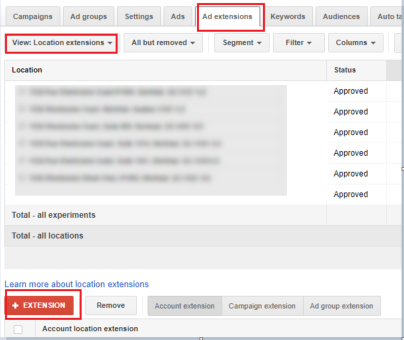Consumers make local searches on every device, everywhere, and at every point in the purchase process. Google tells us that 4 out of 5 consumers use search engines to find local information, and that these users are ready to act:
- 50% of smartphone consumers making local searches will visit a store that same day
- 34% who searched on a computer or tablet are doing the same
- 18% of local smartphone searches lead to a purchase within a day
Clearly, advertisers who are better positioned to display location information in search ads will outperform their competition and drive higher sales. Potential consumers can see in one glance where they can purchase your products, and how far away they are from your physical store location.
If your goal is to drive foot traffic to your stores, Location Extensions in Google AdWords will provide consumers with the information they need to visit and ultimately purchase from you.
How to Setup Google AdWords Location Extensions
Google My Business Account Setup
First you need to setup your Google My Business account with one listing per store. The GMB listing will contain important information relevant to your users and their purchase decision including store location, phone number, website URL, operating hours and user reviews. You have to verify your Google My Business before it appears on Google Maps, organic search or before you can use it in an AdWords ad as a Location Extension.
If you’re managing multiple listings (i.e. you have multiple stores), use one GMB account for all locations. You can only sync one GMB account to an AdWords account, and AdWords Location Extensions will fetch data from the GMB location listing.
If you’re an agency with multiple clients, be sure to use consistent and standardized naming for the Labels and Business Name, and be sure to categorize your GMB listing appropriately. Not only will this help your organic search rank – adding local qualifier terms in the Business Name is a great way to drive up organic visits – but it will be important for filtering Location Extensions in AdWords More on that later.
Adding Location Extensions in AdWords
Next step is to link your Google My Business Account with your AdWords account. Make sure your GMB account is verified and that you have manager-level access to the GMB account.
In AdWords, go to Ad Extensions, then go to the dropdown and click on View: Location Extensions, and then click on the red +Extension
If you’re syncing just one GMB listing, you’re good to go. Pair that listing with any relevant AdWords campaign, fine-tune your location and device bid adjustment, and high-five yourself on a job well done.
That said, if you want to go the extra mile and outfox your competition by poaching their potential customers, read on.
Filtering Location Extensions
Now for the fun part. At my digital marketing agency Imajery, we work with many clients who have multiple store locations within a single city. When creating branded search campaigns, we’ll use location qualifiers as keywords to differentiate each campaign.
For example, if a client has stores in Manhattan, Brooklyn and Queens, we’ll generate keywords using standard branded terms and then break out campaigns for each city, something like:
- Campaign 1: Manhattan – Branded Keywords
- Campaign 2: Brooklyn – Branded Keywords
- Campaign 3: Queens – Branded Keywords
We’ll have already created and verified the three distinct GMB listings for each store location, and we’ll now create and filter separate Location Extensions for each corresponding GMB location. Each location extension will be paired with the city-specific branded search campaign.
Example:
- Campaign 1: Manhattan – Branded Keywords
- Location Extension: Manhattan store
- Campaign 2: Brooklyn – Branded Keywords
- Location Extension: Brooklyn store
- Campaign 3: Queens – Branded Keywords
- Location Extension: Queens store
Pro Tip: Location and Device Bid Adjustment
With branded search campaigns broken out by location, it goes without saying that location targeting and bid adjustments have been made. At Imajery, we like to make granular, micro-location bid adjustments using city or zip code info and pair that with an aggressive mobile bid adjustment. Any user within a relatively small radius of the store using a smartphone is guaranteed to see our ad at the top of the page.
When leveraging RLSA (remarketing lists for search ads) campaigns, we go even more aggressive with both bid and keywords, running the similar location/device bid pairings on generic keywords to users who have previously visited the site.
Why? It’s all about conversion rate. We want to target consumers who:
- are on a smartphone
- are within a short distance to the store
- have previously visited or purchased
This cohort is significantly more likely to purchase, which means we’ll aggressively raise our CPC knowing that conversion rate is expected to be higher.
TL;DR Summary
Here’s what we learned about managing AdWords Location Extensions:
- 4 out of 5 consumers use local search to find information
- 50% of smartphone and 34% of computer/tablet consumers visit a store within one day of making a local search
- 18% of smartphone consumers purchase within one day
- Setup your GMB account to create Location Extensions
- Use one GMB account to manage all your listings
- Filter and pair Location Extensions with location-parsed search campaigns
- Use location and device bid adjustments to go after consumers with a higher likelihood to purchase




